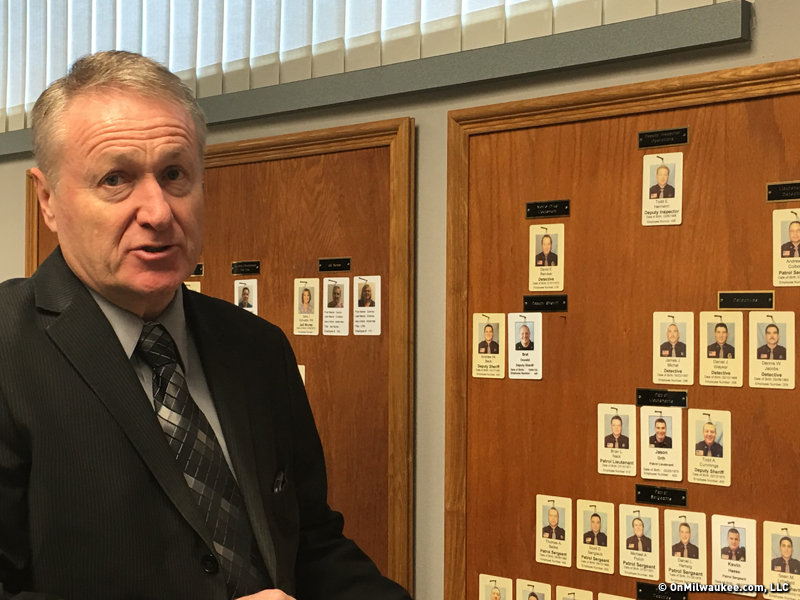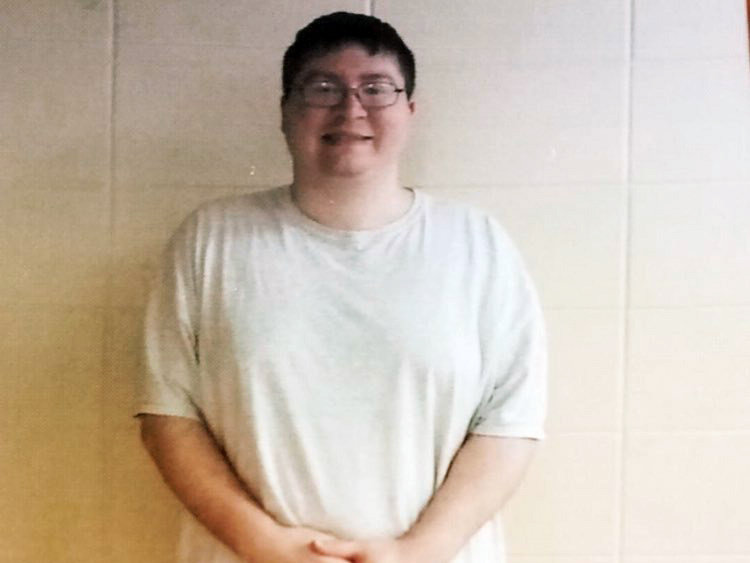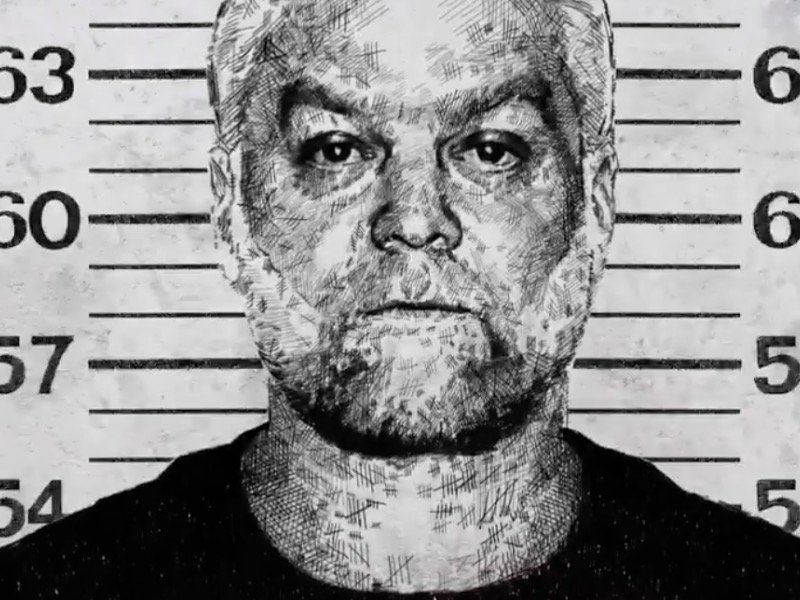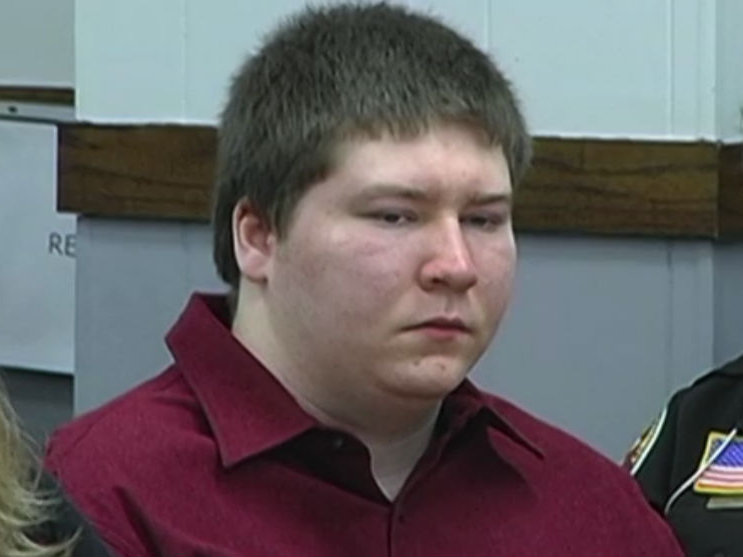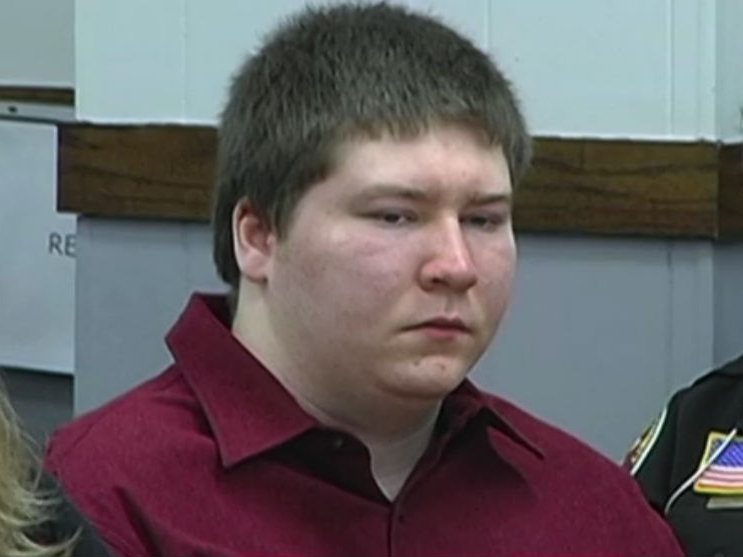MANITOWOC -- Manitowoc County Sheriff’s Department officials have received death threats in the wake of the Steven Avery Netflix documentary "Making a Murderer," and they have contacted the FBI about one of them for further investigation, Sheriff Robert Hermann told OnMilwaukee on Thursday.
In a phone threat, the caller "said something to the effect of if you didn’t hurt yourself, I’d do it for you. With a bullet to the head," said the sheriff. The threat was directed at a department member the sheriff declined to identify.
He said there was a second, more recent death threat that might also be sent by the department to the FBI. And he said the department contacted the FBI and the postal service when an officer received a tube at home that exploded with glitter upon opening. A note was attached that said "for Steven Avery." Hermann said the FBI was also contacted about that before the department discovered the contents of the tube.
"It’s a dirty shame," the sheriff said of the renewed controversy. He said that people are rushing to judgment against his officers in order to accuse them of rushing to judgment against Avery, which he finds contradictory.
He said the defense attorneys – whom he said were good at their jobs – had their chance before a jury, lost and "they are still out there." Of the allegations that his officers planted evidence, he said, it was an "impossible scheme" because of the amount and complexity of evidence, including DNA from Avery’s sweat, blood, bones on his property and so forth (details from the court file on that point in a moment).
He also said that the Manitowoc County Sheriff’s Department should have stayed out of the investigation completely instead of continuing to play a support role – that included its members finding key evidence – after Calumet County investigators took over the case.
"From the benefit of 20-20 hindsight, had we known this would be the defense strategy, yeah, I think that would definitely be the best thing to do," said the sheriff.

The Manitowoc County Sheriff's Department (PHOTO: Jessica McBride)
He said that Calumet is very small and that he doesn’t think his agency did anything wrong by being involved – despite Avery’s ongoing civil suit against the agency for the wrongful conviction case that also involved that same agency. He said the department has been sued before.
"We would probably have been better off turning the whole thing over," said the sheriff. He said the agency was nearest to the scene when the Halbach car was found by citizens on the salvage yard property, and they felt they had to secure the scene.
Hermann – just before an appearance by telephone on the Nancy Grace show and after a meeting with Mark Wiegert and Tom Fassbender, two of the most controversial investigators featured in the Netflix "Making a Murderer" documentary – sat down with OnMilwaukee for a candid, detailed hour-long interview.
OnMilwaukee spotted the two investigators – who netted controversy from the series for interrogating Avery’s 16-year-old nephew Brendan Dassey – walking out of the Sheriff’s Department on Thursday afternoon.
Hermann said he was meeting with Wiegert and Fassbender about "how to handle the media blitz. We are getting a lot of calls. A lot are negative. Some of it is concerning families. Some say things like 'rot in hell,' but others are more in line of what we would consider death threats. It seems to be mostly from out of the area."

Fassbender and Wiegert outside Manitowoc Co. Sheriff's Dept. on Thursday. (PHOTO: Jimmy Carlton)
At the time of the Brendan Dassey interrogations – which occurred with no lawyer or parent present – Fassbender worked for the state and Wiegert for Calumet County law enforcement.
One email referred to the Sheriff’s Department employees as "thugs" and "glorified rent-a-cops." Others are more ominous. Another says in part, "Please, I understand that the majority of law enforcement have an extremely limited education which is why all of you would be doing the State/Country an immense favor by eating a bullet. But hell, it would take years to figure out that you all shot yourselves."
At the end of the interview, the sheriff’s phone rang, and it was a man in another state that Hermann called "one of our supporters." But Hermann said positive calls are dwarfed by negative reaction including from some commentators who allege the Sheriff’s Department killed photographer Teresa Halbach – which the sheriff continues to vigorously deny and which the defense did not contend (the defense instead wanted to point fingers at others in the Avery family itself). Hermann said the department has received several hundred negative communications.
"It affects us all," he said. "People are getting them at home. It disrupts life. People got stuff in the mail. A party bomb. A glitter bomb. It consumes some of us. Dealing with the media." He doesn’t necessarily think the "locals are sharing in that. My theory is local people have been here for the entire case. This case had more evidence than most cases."
He said he is 100 percent sure that Avery did it. Avery’s nephew Brendan Dassey, too.
It’s Hermann’s department that has been at the center of the Internet storm around the Netflix docu-series that focuses on the defense narrative that Manitowoc Sheriff’s Department officers may have planted evidence against Steven Avery – which Hermann vigorously disputes. At the time of the investigation, Hermann was Manitowoc County under-sheriff.

Hermann discusses the Avery case with OnMilwaukee. (PHOTO: Jessica McBride)
Hermann also agreed to address specific allegations in the documentary, which he said he watched over two days over the holidays. He said the actual case is a "huge puzzle. When you start to miss pieces, you lose part of that puzzle." He said the documentary was incomplete, despite the fact that the filmmakers have told the media they tried to present the state’s best evidence and were fair.
Hermann said Avery told investigators he had never touched Teresa Halbach’s vehicle even though his DNA was found in it from blood and sweat, including under a hood. He believes Avery and the documentary minimized things repeatedly. For example, he said, he thought Avery had downplayed the earlier incident where he had killed a cat in the documentary. "No, he put gas and oil on it. He tossed it in a fire," said the sheriff.
A review by OnMilwaukee of court transcripts shows that the state alleged at trial that Avery’s DNA was found in many locations in the Halbach vehicle and that he had a cut on his finger. The opening statement said his blood was found in "at least six places in Teresa Halbach’s SUV including the rear passenger door, smeared or wiped on the rear passenger door. It was in the backdoor, and it’s along the edge or along the metal of the rear passenger door. That’s Steven Avery’s blood ...
"We have heard about the defendant’s blood on the ignition. That positively matched that of Steven Avery … Other places that the defendant bled inside of the victim’s car included blood on her CD case in her front seat. Both front seats had droplets of Mr. Avery’s blood on it. The rear tailgate … there is a droplet of his blood as well. And also on the front console floor." DNA from Avery’s sweat, said the prosecutor, was also found on the hood latch of the car – which Dassey allegedly told investigators he saw Avery lift open – and on the key used to "start the ignition."
Did his officers plant evidence?
"They are very good officers," Hermann said. "I trust them. They are well-trained." He said they had no motive to frame Avery because the two officers featured in the documentary most – James Lenk and Andrew Colburn – were not even mentioned as defendants in Avery’s civil suit, which named the county, sheriff and DA. "Those officers were not named in the lawsuit." He said Lenk has retired and Colburn declined an interview with OnMilwaukee because the Dassey case is still pending in Federal Court.
Did the agency have animus to Avery?
The sheriff denied this. "They were known to us," he said. But, he added, in a 33-year career, he was on the property maybe a "half dozen times" and only once outside of the Halbach case. He said the department patrols 600 square miles with a little over 110 officers. The Avery compound is near Mishicot about 20 minutes from the Sheriff’s Department headquarters.
After watching the documentary, did he think anything seemed fishy at all?
"No," he said.
What about Lenk finding Halbach’s car key in Avery’s bedroom after other investigators had missed it for eight days? Especially considering some 70-100 officers were on the property at any given time?
"It was good police work (by Lenk)," the sheriff said. "Unfortunately, sometimes when people look over things they miss things." He said there are national cases where bodies are undetected for years.
As to planting the car, he said he’d heard, "If you went on the property, the Avery’s knew." He said Avery had a dog that would have warned him of someone on the property.

The sign for the Avery's property (PHOTO: Jessica McBride)
Why was none of Halbach’s blood found in Avery’s house or garage?
He said, "A .22 round makes a small hole. There’s not going to be a lot of blood. And what were they doing in the garage with bleach cleaning it? Bedding with blood could have been burnt. It’s like a puzzle." Hermann pointed out that the Halbach bone fragments were mixed with steel belts from tires, and he said the contention that some of her bones were found in a quarry pit near the property was unproven.
On the topic of why Colburn called in Halbach’s plate to dispatch before the car was found:
"He didn’t have the vehicle in front of him. This was the vehicle they were looking for. This is a vehicle we were looking for." He said an officer from Calumet County had called Colburn to give him the plate number and vehicle description because Calumet had determined Halbach was last in Manitowoc County, so Colburn would know what he was looking for.
So, why would he need to call dispatch, then?
"He was a shift commander. He was thorough."
We asked the sheriff if he has any concerns about the Dassey confessions, since Dassey had no lawyer and parent present and has a low IQ – and since there was no blood found in the bedroom.
The sheriff said his agency didn’t handle the confessions and that he would have to watch the entire 3.5-4 hours not just the parts played on Netflix. But he said he doesn’t have doubts about the Dassey case. "I trust the investigators."
Does he believe Avery was wrongfully convicted of the sexual assault?
"No one ever talked to Gregory Allen. But it’s unfortunate. Are we happy about it (that DNA showed they had the wrong man)? No."
The sheriff believes that, "We have one of the best criminal justice systems in the world, and one of the finest in Wisconsin. This has had a huge negative impact from outside, from other countries even. It’s very untrue and unfair."
Additional notes:
According to the defense opening statement in the trial transcripts, Lenk and Colburn searched the property many times and were involved immediately after Halbach went missing.
Calumet County Sheriff’s Department called Manitowoc for help on the missing person’s report after learning that Halbach’s last stops had been in Manitowoc County, including on the Avery property. It says Colburn was told to check out two places and only went to the Avery home. He talked to Avery who denied knowing anything and was cooperative.
"Out of the blue, the same night, Lt. James Lenk … calls Calumet about this missing person report" without anyone calling for him. The next day, Lenk went to the trailer with another Manitowoc officer and again talked to Avery. Avery was cooperative and denied any involvement. According to the defense opening statement, Lenk walks through Avery’s trailer, sees nothing amiss, and then leaves.
The next day, the citizens find the Halbach vehicle on the property. First to arrive: Manitowoc County Sheriff’s Department.
Lenk allegedly changed his story about the time he arrived at the Avery property that day and didn’t sign into the log sheets, although he did sign out. At that point, the department turned the case over to Calumet as lead agency.
That day, Lenk and Colburn searched Avery’s trailer and see nothing. The next day, they return to the trailer again and search his garage. They find .22 casings. On Nov. 7, the trailer is searched against by Lenk and Colburn. They find nothing of interest. On Nov. 8, Lenk and Colburn are back. And that’s when Lenk finds the key.
- Jimmy Carlton contributed to this report.
Jessica McBride spent a decade as an investigative, crime, and general assignment reporter for the Milwaukee Journal Sentinel and is a former City Hall reporter/current columnist for the Waukesha Freeman.
She is the recipient of national and state journalism awards in topics that include short feature writing, investigative journalism, spot news reporting, magazine writing, blogging, web journalism, column writing, and background/interpretive reporting. McBride, a senior journalism lecturer at the University of Wisconsin-Milwaukee, has taught journalism courses since 2000.
Her journalistic and opinion work has also appeared in broadcast, newspaper, magazine, and online formats, including Patch.com, Milwaukee Magazine, Wisconsin Public Radio, El Conquistador Latino newspaper, Investigation Discovery Channel, History Channel, WMCS 1290 AM, WTMJ 620 AM, and Wispolitics.com. She is the recipient of the 2008 UWM Alumni Foundation teaching excellence award for academic staff for her work in media diversity and innovative media formats and is the co-founder of Media Milwaukee.com, the UWM journalism department's award-winning online news site. McBride comes from a long-time Milwaukee journalism family. Her grandparents, Raymond and Marian McBride, were reporters for the Milwaukee Journal and Milwaukee Sentinel.
Her opinions reflect her own not the institution where she works.

